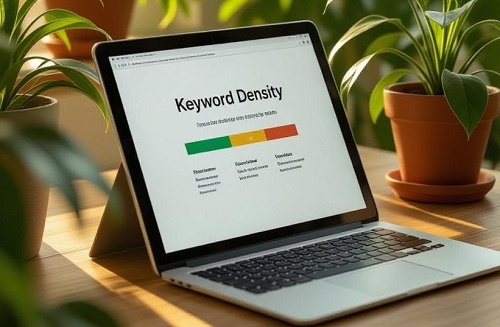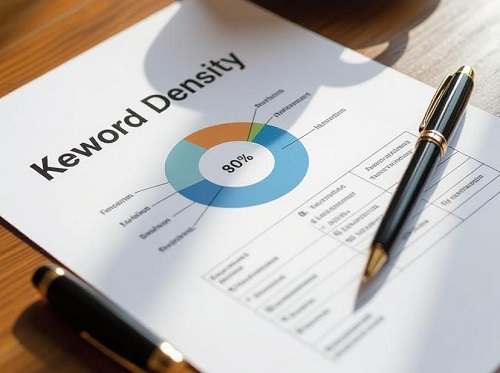Free Keyword Density Checker Tool for Better On-Page SEO
Table of Contents
- What is Keyword Density?
- The History of Keyword Density in SEO
- Why Keyword Density Still Matters in 2025
- What Happens if You Ignore Keyword Density?
- How Our Keyword Density Checker Tool Works
- How to Calculate Keyword Density Manually
- Ideal Keyword Density for SEO
- Benefits of Using Our Keyword Density Tool
- Keyword Density vs. Keyword Stuffing
- Optimize With LSI Keywords & Semantic SEO
- Pro Tips for Better Keyword Density
- Common Mistakes to Avoid
- Why Choose Our Keyword Density Checker?
- Comparison of Keyword Density Tools
- Conclusion
If you want to rank higher on Google, mastering keyword usage is a must. Our Keyword Density Checker helps you analyze your content, avoid keyword stuffing, and optimize for a natural flow that boosts SEO performance. In this guide, we’ll explain why keyword density matters in 2025 and how to use our tool effectively to enhance your search engine rankings.
Whether you’re a blogger, marketer, or business owner, understanding and managing keyword density can significantly impact your website’s visibility. This tool is designed to make keyword optimization simple, ensuring your content aligns with Google’s latest algorithms while keeping readers engaged. Let’s dive into the details!

What is Keyword Density?
Keyword density refers to the percentage of times a keyword or phrase appears in your content compared to the total word count. For example, if your target keyword appears 15 times in a 1,500-word article, the keyword density is 1%. This metric helps search engines understand the topic of your content without penalizing you for overuse.
A balanced keyword density ensures your content is relevant to search queries while maintaining readability for your audience. Too high a density can lead to penalties, while too low can make your content less relevant to search engines. Our tool simplifies this process by providing a clear analysis of your keyword usage.
The History of Keyword Density in SEO
In the early days of SEO, keyword density was a primary ranking factor. Webmasters would stuff pages with keywords to manipulate search engine results, often at the expense of readability. Google’s Panda and Penguin updates in the early 2010s changed this by penalizing keyword stuffing and prioritizing quality content.
Today, keyword density is still relevant but part of a broader SEO strategy that includes user intent, content quality, and semantic relevance. Modern algorithms focus on context and user experience, making tools like our Keyword Density Checker essential for staying compliant with Google’s guidelines in 2025.

Why Keyword Density Still Matters in 2025
While Google’s algorithms have become more sophisticated, keyword density remains a key on-page SEO metric. Here’s why it’s still important:
- Clarifies page topic for search engines.
- Improves content relevance for targeted search queries.
- Enhances user engagement with natural keyword integration.
- Prevents penalties from over-optimization or keyword stuffing.
In 2025, Google’s algorithms prioritize user-focused content. A well-optimized keyword density ensures your content aligns with both search engine requirements and reader expectations, making it a critical factor for ranking success.
What Happens if You Ignore Keyword Density?
Ignoring keyword density can lead to two major SEO issues:
- Keyword Stuffing: Overusing keywords can make your content appear spammy, triggering Google penalties that lower your rankings.
- Low Relevance: Using too few keywords can confuse search engines about your content’s topic, reducing its chances of ranking well.
Both scenarios harm your SEO performance. Our Keyword Density Checker helps you avoid these pitfalls by providing actionable insights into your keyword usage.

How Our Keyword Density Checker Tool Works
Our tool is designed to be user-friendly and effective. Here’s how it works:
- Input Content: Paste your text or enter a webpage URL.
- Content Analysis: The tool scans your content, ignoring common filler words (e.g., "the," "and").
- Density Calculation: It calculates the percentage of keyword usage for single, double, and triple-word phrases.
- Detailed Report: You receive a clear report showing keyword frequency and density, along with optimization suggestions.
This process ensures you can quickly identify areas for improvement and optimize your content for better SEO performance.
How to Calculate Keyword Density Manually
While our tool automates the process, understanding how to calculate keyword density manually can be helpful. Here’s the formula:
Keyword Density (%) = (Number of Keyword Appearances ÷ Total Word Count) × 100
For example:
- A 2,000-word article with a keyword appearing 20 times has a density of (20 ÷ 2,000) × 100 = 1%.
- A 1,000-word blog post with a keyword used 15 times has a density of (15 ÷ 1,000) × 100 = 1.5%.
Manual calculation is time-consuming, especially for long content. Our tool saves you time by providing instant, accurate results.
Ideal Keyword Density for SEO
SEO experts generally recommend a keyword density of 1% to 2% for primary keywords. Here’s a quick guide:
| Content Length | Ideal Keyword Mentions | Keyword Density |
|---|---|---|
| 500 words | 5–10 mentions | 1–2% |
| 1,000 words | 10–20 mentions | 1–2% |
| 2,000 words | 20–40 mentions | 1–2% |
These ranges help maintain a natural flow while ensuring search engines recognize your content’s relevance.
Benefits of Using Our Keyword Density Tool
Our tool offers several advantages for content creators and SEO professionals:
- Enhanced On-Page SEO: Achieve the right keyword balance for better rankings.
- Improved Readability: Ensure your content flows naturally for readers.
- Penalty Protection: Avoid over-optimization risks that harm rankings.
- Keyword Opportunities: Discover secondary keywords to expand your content’s reach.
- Competitor Analysis: Analyze competitors’ keyword usage to refine your strategy.

Keyword Density vs. Keyword Stuffing
Keyword density is about achieving balance, while keyword stuffing involves overusing keywords to manipulate rankings. Google’s algorithms in 2025 prioritize content written for humans, not bots. Overloading your content with keywords can lead to penalties, while a balanced density improves rankings and user experience.
Healthy keyword density boosts SEO. Keyword stuffing destroys rankings.
Our tool helps you maintain this balance by highlighting overused keywords and suggesting improvements.
Optimize With LSI Keywords & Semantic SEO
Modern SEO goes beyond repeating a single keyword. Google uses Latent Semantic Indexing (LSI) keywords and semantic SEO to understand content context. LSI keywords are synonyms or related terms that add depth to your content. For example, for the keyword "SEO tools," LSI keywords might include "keyword analysis," "on-page optimization," or "website checker."
Our Keyword Density Checker identifies these variations, helping you incorporate them naturally to improve your content’s relevance and ranking potential.

Pro Tips for Better Keyword Density
Here are some expert tips to optimize your keyword usage:
- Strategic Placement: Include your primary keyword in the title, meta description, and first paragraph.
- Natural Distribution: Spread keywords evenly across headings, subheadings, and body text.
- Use Synonyms: Incorporate LSI keywords and synonyms to add variety and context.
- Prioritize User Intent: Write for your audience first, ensuring content answers their questions.
- Test Before Publishing: Use our Keyword Density Checker to review your content before going live.
Common Mistakes to Avoid
Avoid these pitfalls to ensure effective keyword optimization:
- Overusing Keywords: Repeating the same keyword excessively harms readability and rankings.
- Ignoring LSI Keywords: Failing to include related terms limits content depth.
- Prioritizing SEO Over Quality: Content should always be reader-friendly first.
- Unnatural Anchor Text: Avoid awkward or spammy link text in your content.
- Neglecting Updates: Refresh old content with updated keywords to maintain relevance.

Why Choose Our Keyword Density Checker?
Our Website SEO Checker stands out with these advanced features:
- Accurate Reports: Get precise keyword frequency and density analysis.
- Multi-Word Analysis: Analyze single, double, and triple-word phrases.
- URL Scanning: Evaluate entire webpages with a single URL input.
- Overuse Detection: Identify keywords that risk triggering penalties.
- Custom Recommendations: Receive tailored suggestions to improve your content.
Comparison of Keyword Density Tools
Here’s how our tool compares to other popular keyword density checkers:
| Feature | Our Tool | Tool A | Tool B |
|---|---|---|---|
| Free to Use | Yes | Paid | Yes |
| URL Analysis | Yes | Yes | No |
| LSI Keyword Suggestions | Yes | No | No |
| Multi-Word Phrase Analysis | Yes | Yes | No |
| SEO Recommendations | Yes | No | Limited |
Our tool’s comprehensive features make it a top choice for content creators aiming to optimize their SEO strategy.
Conclusion
Keyword density remains a critical component of on-page SEO in 2025. By maintaining a natural keyword balance, avoiding stuffing, and incorporating LSI keywords, you can create content that ranks higher and engages readers effectively. Our free Keyword Density Checker tool simplifies this process, providing accurate analysis and actionable insights.
Whether you’re optimizing a blog post, product page, or entire website, our tool helps you achieve better rankings without the risk of penalties. Try it today and take your SEO strategy to the next level!
Related Blogs
Free vs Paid Video Editing Tools: Which Should You Use?
A comparison of free and paid video editing tools to help you choose the best one for your needs.
YouTube Monetization Checker: A Complete Guide for 2025
Understand how to use a YouTube Monetization Checker to estimate your channel's earning potential.
YouTube Title Generator Tips 2025
Tips and tools for generating catchy YouTube titles that boost clicks and views in 2025.
How to Pick a YouTube Niche: A Step-by-Step Guide for 2025
A complete guide to choosing the perfect YouTube niche that attracts viewers and grows your channel.
Keyword Density Checker: Importance for On-Page SEO
Understand why keyword density matters and how to optimize your on-page SEO effectively.
Storytelling on YouTube: Turning Simple Topics into Engaging Content
Learn storytelling techniques to transform basic topics into engaging YouTube videos.
Beyond AdSense: 10+ Ways to Make Money on YouTube in 2025
Explore multiple ways to earn revenue on YouTube beyond AdSense in 2025.
How to Use Website SEO Checker to Improve Rankings
Learn how to effectively use our Website SEO Checker to boost your search rankings and traffic.
How the YouTube Algorithm Works in 2025: A Complete Guide for Creators
Understand the YouTube algorithm and how to leverage it to grow your channel effectively.
Shorts Idea Generator Guide: How to Create Viral YouTube Shorts in 2025
A complete guide on using a Shorts idea generator to create viral YouTube Shorts in 2025.